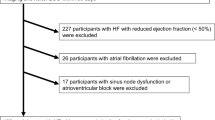Summary
Serum levels of T4, T3 rT3 and resin T3 uptake were followed for 5 days in 40 patients with acute myocardial infarction (AMI) allocated to early treatment either with alprenolol or placebo. There was a significant fall in T3 (P<0.05) and an increase in rT3 (P<0.05) without any significant difference between the alprenolol — (n=19) and placebo — (n=21) treated groups. The risk of missing a further 20% change in se-T3 and se-rT3 after alprenolol compared to placebo treatment (β) was <0.10 and <0.50, respectively. In patients with a severe clinical course, the fall in T3 and increase in rT3 was significantly greater than in patients without complications. No change in T4 was observed either with respect to the clinical course nor following alprenolol. The data suggest that alprenolol can be given in the acute phase of myocardial infarction without causing any additional disturbance in the serum levels of T3 and T4.
Similar content being viewed by others
References
Chopra IJ, Chopra U, Smith SR, Reza M, Solomon DH (1975) Reciprocal changes in serum concentrations of 3,3′,5′-trijodothyronine (reverse T3) and 3,5,3′-triiodothyronine (T3) in systemic illness. J Clin Endocrinol Metab 41: 1043–1049
Weeke J, Lauerberg P, Olsen T (1978) Incidence of abnormal serum concentrations of thyroid hormones and reverse T3 in patients without thyroid disease. Ugeskr Laeger 140: 2012–2014
Lumholtz IB, Busch-Sørensen M, Faber J, Friis T, Kirkegaard C, Siersbaek-Nielsen K (1979) The influence of propranolol on the extrathyroidal metabolism of 3,3′,5′-triiodothyronine (reverse T3) Acta Med Scand 624: 31–34
Perrild H, Hansen JM, Skovsted L, Christensen LK (1983) Different effects of propranolol, alprenolol, sotalol, atenolol and metoprolol on serum T3 and reverse T3 in hyperthyroidism Clin Endocrinol 18: 139–142
Perrild H, Pedersen F, Rasmussen SL, Jürgensen HJ, Skovsted L (1984) Long-term alprenolol treatment affects serum T4, T3 and rT3 in euthyroid patients with ischaemic heart disease Acta Endocrinol (Kbh) 105: 190–193
Faber J, Kirkegaard C, Lumholtz IB, Siersbaek-Nielsen K, Friis T (1980) Variations in serum T3, rT3, 3,3′-diiodothyronine induced by acute myocardial infarction and propranolol Acta Endocrinol (Kbh) 94: 341–345
Smith SJ, Bos G, Gerbrandy J, Docter R, Visser TJ, Hennemann G (1978) Lowering of serum 3, 3′,5-triiodothyronine thyroxine ratio in patients with myocardial infarction: relationship with extent of tissue injury Eur J Clin Invest 8: 99–102
Westgreen U, Burger A, Levin K, Melander A, Nilson G, Pettersson U (1977) Divergent changes of serum 3, 5, 3′-triiodothyronine and 3, 3′, 5′-triiodothyronine in patients with acute myocardial infarction Acta Med Scand 201: 269–272
Wiersinga WM, Lie KI, Touber JL (1981) Thyroid hormones in acute myocardial infarction Clin Endocrinol 14: 367–374
Faber J, Friis T, Kirkegaard C, Lumholtz IB, Hansen JM, Siersbaek-Nielsen K, Skovsted L, Theilade P (1979) Serum T4, T3 and reverse-T3 during treatment with propranolol in hyperthyroidism, L-T4 treated myxoedema and in normal man Horm Metab Res 11: 34–36
Rotti G, Delitale G, Desilla L, Alagna S, Masale A (1977) Reduction of plasma triiodothyronine (T3) induced by propranolol Clin Endocrinol 6: 405–410
Kristensen BØ, Weeke J (1977) Propranolol induced increments in total and free serum thyroxine in patients with essential hypertension Clin Pharmacol Ther 22: 864–868
WHO Ischaemic heart disease register, WHO, Copenhagen 1971
Andersen MP, Bechsgaard P, Frederiksen J, et al. (1979) Effect of alprenolol on mortality among patients with definite or suspected acute myocardial infarction. Preliminary results. Lancet ii: 865–868
Siersbaek-Nielsen K (1967) Determination of serum thyroxine Acta Med Scand 181: 327–333
Skovsted L (1979) Radioimmunoassays of T3, rT3 and rT2′ in human serum Acta Med Scand Suppl. 624: 19–24
Hansen HH (1964) The binding of L-triiodothyronine to plasma protein Ugeskr Laeger 126: 1471–1474
Rosalki SB (1967) An improved procedure for serum creatine phosphokinase determination J Lab Clin Med 69: 696–705
Lown B, Wolf M (1971) approaches to sudden death from coronary heart disease Circulation 44: 130–139
Juhl E, Christensen E, Tygstrup N (1982) How are negative controlled clinical investigations interpreted? Hepato-, gastro-, enterological randomized investigations from a ten-year period with insignificant results. Ugeskr Laeger 144: 2913–2918
Azizi F (1978) Effect of dietary composition on fasting — induced changes in serum thyroid hormones and thyrotropin Metabolism 27: 935–942
Chopra IC, Williams DF, Orgiazzi J, Solomon DH (1975) Opposite effects of dexamethasone on serum concentrations of 3, 3′,5′-triiodothyronine (reverse T3) and 3, 5, 3′-triiodothyronine (T3) J Clin Endocrinol Metab 41: 911–920
Nauman A, Lewartowski B, Nauman J, Kaminski T, Michalowski J, Sedek G (1975) Triiodothyronine in experimental myocardial infarction in dogs. Eur J Clin Invest 5 Abstr 95: 338
Nauman J, Nauman A, Kubica A, Kaminski T, Lewartowski B, Ceremuzynski L, Herbaczynska-Cedro K (1976) Specific nuclear receptors for T3 in experimental myocardial infarction and after adrenaline infusion Eur J Clin Invest 6 Abstr 232: 339
Author information
Authors and Affiliations
Rights and permissions
About this article
Cite this article
Pedersen, F., Perrild, H., Rasmussen, S.L. et al. “Low T3-syndrome” in acute myocardial infarction — Relationship to beta-adrenergic blockade and clinical course. Eur J Clin Pharmacol 26, 669–673 (1984). https://doi.org/10.1007/BF00541923
Received:
Accepted:
Issue Date:
DOI: https://doi.org/10.1007/BF00541923




